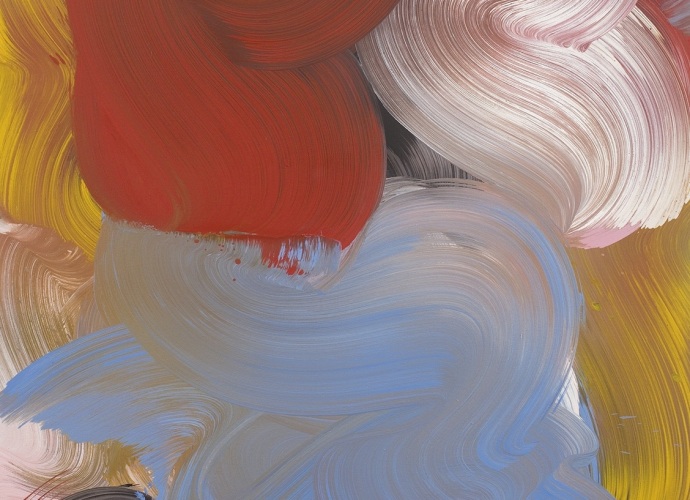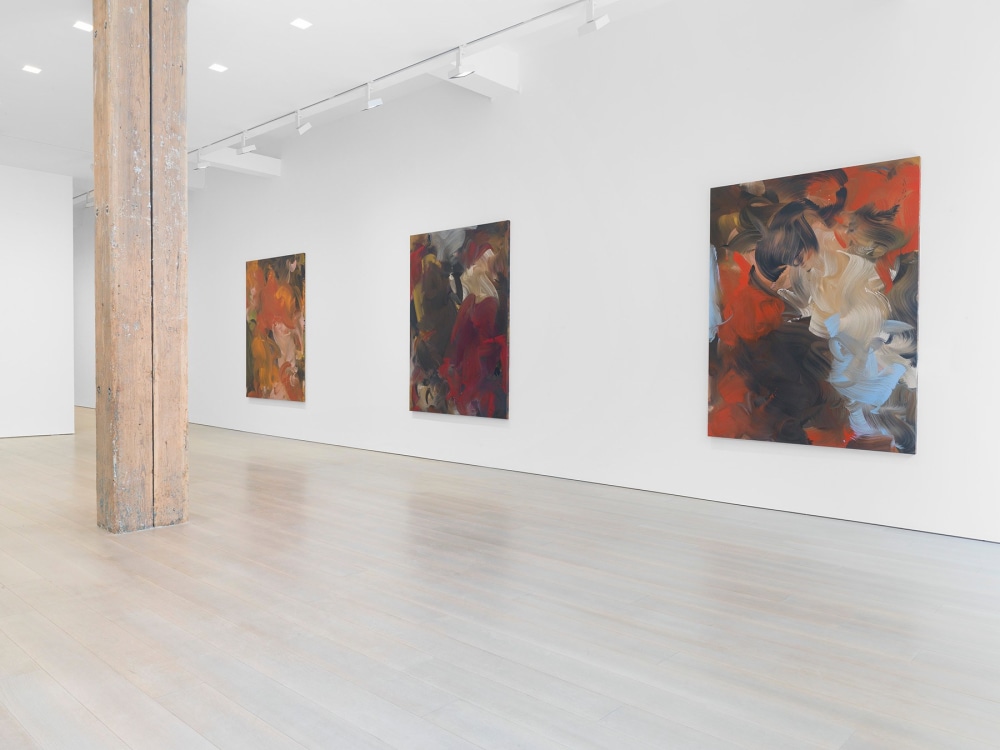
Erin Lawlor | Arte Fuse
Review by Patti Jordan
6 August 2019

An inaugural solo exhibition of the work of London-based artist Erin Lawlor presents a selection of vivid paintings spanning 2017 – 2019 and evinces advancements in the artist’s trademark brushwork, color usage, and compositional formats. The works in this series build upon painting explorations consisting of a loopy, curvilinear patchwork that produces heightened subtleties between foreground, middle-ground, and background. Constructed from a multitude of axial planes that fully exploit levels of push-pull between the nip, tuck, and fold of her envisioned spaces, Lawlor’s dynamic imagery elicits an impeded desire to peel back layers of curvature that seem to go on interminably.
It is in such momentary experiences with this series that the topic of infinite folds come into play. In the exhibition catalog, “Erin Lawlor: The Fold,” author Zoe Miller poignantly quotes Gilles Deleuze in “Foucault” in which Deleuze writes,
The outside is not a fixed limit but a moving matter animated by peristaltic movements, folds and foldings that together make up an inside: they are not something other than the outside, but precisely the inside of the outside (97).
To this point, Lawlor’s production of multitudinous curving form carries duplicity through the coexistent appearance of depth and façade – an unfolding, interior and exterior veneer that demands its audience mentally, and more or less physically, sweat a bit to break the code and penetrate. Amidst all of these curvaceous simulacra, the element of time is likewise aroused.
Lawlor’s painting practice is defined by somewhat narrow compositional tendencies and mannerisms that set a decisively singular tone. Like many of her process-oriented contemporaries, Lawlor works wet on wet – a painting method that embraces spontaneity and leaves ample room for chance and improvisation to eventualize in her visual outcomes. Yet, contributing to her self-consciously limited surface treatments is a distinctive, branded brushwork that appears as though it might not be produced with a brush, but with a large-tooth comb. In fact, Lawlor places her canvases on the floor and then veritably sweeps over them repeatedly in circular motions with a large wallpaper brush, creating multiple striated layers.
Such painting methods, specifically her layering techniques, make for slight albeit effective creative disruptions in her compositional strategies. Sublime accidents of pure and amalgamate color are caught on the bristles of her brush and create planar swoops of ascending and descending gestural motion. The verisimilitude of this action is further indicated by the multiple drips on the sides of her canvases. In the aftermath, Lawlor’s visuals assume an implicit strength through how she manages to shuffle these constructed layers of curling form into a series of opportune positions in her painting deck, wherefore an architectural pecking order gets established and appears to metamorphose into a virtual, embodied meaning. Thus, an irresistible momentum is established in her structures, accentuated by deepened areas that push contrast and saturation that result in the aforementioned hierarchies in her cavernous spaces.
In the process of situating the work, one cannot confirm that this imagery is in lack of historical content. Although primarily drawing upon the contemporary languages and formats of abstraction, these canvases surreptitiously call forth a redaction of historical painting through imaginary predecessors conjured by areas of blurred brush, or form, and discrete choices in pigment: ochre, umber, and raw and burnt sienna are activated in the eye and mind. Such parallels hint at visual narratives running through Lawlor’s aesthetic that can’t help but appear linked to representation. In “morning rises” (2018), Lawlor’s infinitely overlapping forms create the impression of rural regions or water currents depicted in aspects of classical landscape painting.
Modes of the figural are somehow also lurking, embodied in the paint through emphatic gestures and flesh tones that are interspersed throughout the work. Similar to subtle, asymmetrical arrangements reminiscent of contrapposto painting in which the axes of the arms and shoulders diverge from those of the hips and legs, an overriding centrality is present in the construction of her canvases. This formal tendency hinges the works to some degree, whilst gossamer overlays of high-keyed yellow, orange, red and blue add thrust as they become overtly apparent, such as in “three white leopards” (2018), and the diptych, “pull + ebb” (2018).
In some sense, the color schemes in this series are rather thematic and can at first glance appear to be a bit formulaic. If there’s an impression of a certain chromatic redundancy it is felt in some of the diptychs and triptychs back of gallery which incorporate larger masses of neutrals, flesh tones, and dusky color; this tends to lessen their formal tension slightly. Nonetheless, Lawlor employs color quite ambitiously to create balanced juxtapositions vacillating between saturation and contrast that ultimately exhume an expansive effect. This underlying formal resoluteness results in an unyielding cohesion in the overall presentation.
As aforementioned, Lawlor’s brush strokes endlessly writhe on their axial planes, and in this way, gestural form becomes a motif. To her credit, her abstractions’ tenuous relationship to representational painting induces friction that undoubtedly invigorates the work. In both structure and methodology, the paintings displayed are endowed with a vigor endemic to work realized through the immediacy of the creative process. One can surmise in viewership that a magnetism is induced by her chromatic folds, an inherent force that pulls one in – and out – of coinciding minimal and ornamental space, creating a continuum. In summation, Lawlor’s bending configurations, which set out to hold the space through a quasi-reverent abstraction, furtively imply that what may not be represented in actuality, is there in essence.
Erin Lawlor holds a Bachelor of History of Art from the University of Paris IV – La Sorbonne, Paris, France and currently resides in London, United Kingdom. Recent solo exhibitions include “Here to the Hidden Hills,” Fifi Projects, San Pedro, Mexico; “Erin Lawlor,” Fox/Jensen/McCrory, Auckland, New Zealand; and “Cat on the raz,” Espacio Valverde, Madrid, Spain. Lawlor’s inaugural solo exhibition at Miles McEnery Gallery will be on view July 11 through August 16, 2019. Photos Courtesy of the artist and Miles McEnery Gallery, New York, NY.